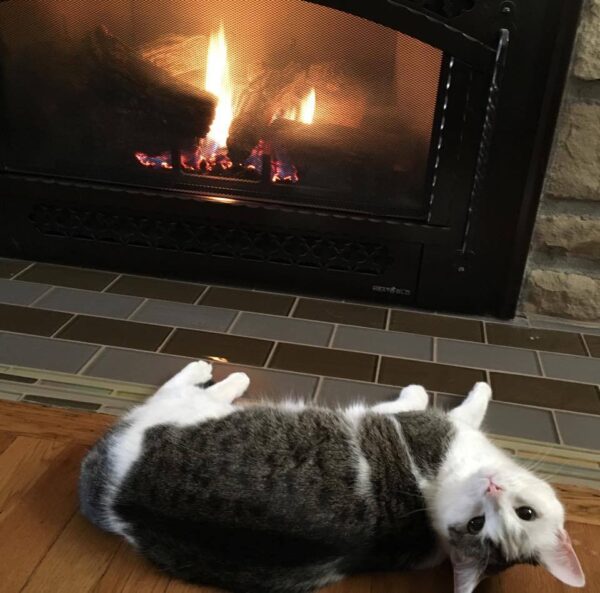
Please consult your veterinarian with any concerns you have about your cat.
Feline Hyperesthesia Syndrome: Understanding and Managing Your Cat’s Condition
Feline Hyperesthesia Syndrome (FHS) is a rare and poorly understood disorder affecting cats, characterized by sudden, intense episodes of hyperactivity, muscle spasms, and apparent skin sensitivity, particularly along the spine. During these episodes, affected cats may exhibit a range of behaviors including frantic grooming of the flank or tail, tail chasing, vocalizations, and even self-mutilation. Understanding this condition is complex due to the variability in symptoms and the fact that many of the behaviors can be seen in normal cats as well.
The exact causes of FHS remain unclear, but the condition has been associated with psychological stress, neurological abnormalities, or skin disorders. Diagnosis involves a thorough examination to rule out other conditions that could cause similar symptoms, such as dermatological or neurological diseases. Veterinary professionals often develop an integrated diagnostic approach, incorporating behavioral assessments alongside medical tests. Treatments are equally multifaceted, tailored to each individual cat, and can include medications to control symptoms, dietary modifications, environmental enrichment, and strategies to minimize stress.
Key Takeaways
- Feline Hyperesthesia Syndrome is a complex condition with episodes of hyperactivity and skin sensitivity.
- Diagnosis requires careful elimination of other conditions, with a focus on neurological and dermatological health.
- Treatment is personalized, often including medications, diet changes, and stress reduction.

Understanding Feline Hyperesthesia Syndrome
Feline Hyperesthesia Syndrome presents as a perplexing behavioral and medical condition. It baffles both owners and veterinarians due to its multifaceted nature and the array of symptoms that may suggest neurological and dermatological origins.
Definition and Symptoms
Hyperesthesia Syndrome, commonly referred to as Feline Hyperesthesia Syndrome, is characterized by episodes of extreme sensitivity to touch and stimuli, particularly along the lower back. Symptoms can include:
- Dilated pupils: Indicative of heightened sensory reaction or distress
- Tail chasing, licking, or biting: Cats may fixate on their tail as if bothered by it
- Skin rippling: Visible muscle contractions on the back
- Aggressive grooming: Intense licking that can lead to hair loss and skin injury
- Aggressive behavioral patterns: Including vocalization and apparent discomfort
- Seizure-like episodes: In severe cases, cats may exhibit seizure behaviors
Possible Causes and Triggers
While the exact causes of Feline Hyperesthesia Syndrome are not fully understood, potential triggers and associated conditions include:
- Neurological causes: Including epileptic phenomena suggested by seizure-like symptoms
- Psychological causes: Stress can exacerbate symptoms, hinting at a potential link with Obsessive-Compulsive Disorder
- Dermatological causes: Allergies or infections may trigger skin-related symptoms
The condition’s complexity may derive from an interplay between multiple factors such as neurological irregularities, psychological stressors, and dermatological issues. Due to the similarities with human neuropathic pain conditions, Epilepsy has been considered a possible underlying factor, given that some of the symptoms align with epileptic seizures. However, not all symptoms correspond to epileptic episodes, indicating that the syndrome might stem from a broader neurological base.
Breed Predispositions for Feline Hyperesthesia Syndrome

In the realm of feline health, certain breeds are more susceptible to developing Feline Hyperaesthesia Syndrome (FHS), a condition characterized by sudden, exaggerated skin sensitivity, typically along the spine.
Commonly Affected Breeds
| Breed | Genetic Link Noted |
|---|---|
| Burmese | Yes |
| Siamese | Yes |
| Abyssinian | Possible |
| Persian | No specific link reported |
Among the breeds, Burmese and Siamese cats stand out as particularly prone to Feline Hyperaesthesia Syndrome. Research suggests a genetic component in these breeds, which places them at higher risk. Additionally, Abyssinians are sometimes mentioned, though a clear genetic link requires further investigation. While not definitively linked, it is not unheard of in Persians and various Asian breeds, hinting at a broader susceptibility in feline breeds that may possess shared genetic traits. It is crucial for breeders and potential cat owners to be aware of these predispositions for more informed breeding and healthcare practices.
Diagnosis Process for Feline Hyperesthesia Syndrome
The diagnosis process for Feline Hyperesthesia Syndrome (FHS) is meticulous and requires a combination of clinical examination and advanced diagnostic tests to rule out other conditions that may present similar symptoms.
Clinical Examination
A veterinarian begins the diagnosis with a thorough clinical examination. They look for the hallmark signs of FHS: skin rippling, excessive grooming, and sensitivity to touch along the back. During this examination, the veterinarian observes the cat’s behavior, muscle spasms, and any signs of self-trauma—such as lesions on the cat’s tail due to biting or licking.
Advanced Diagnostic Tests
For a conclusive diagnosis, advanced diagnostic tests are necessary. These may include:
- Blood Work: Essential to exclude other systemic diseases that can mimic FHS symptoms.
- Allergy Tests: Performed to rule out allergic reactions causing the skin irritation.
- X-Rays: Used to check for spinal problems, such as fractures or arthritis, that could be causing discomfort.
- Magnetic Resonance Imaging (MRI): Helps in obtaining a detailed image of the cat’s spinal cord and the structure of the brain, identifying any abnormalities that could contribute to the syndrome’s symptoms.
Each test contributes to a comprehensive Diagnostic Workup, ensuring that the treatment plan is tailored to the cat’s specific condition.

Treatment Strategies For Feline Hyperesthesia Syndrome
When approaching the treatment of Feline Hyperaesthesia Syndrome (FHS), professionals aim to alleviate symptoms and improve the cat’s quality of life through a multifaceted approach, which often includes medication, behavior modification, and the management of related conditions.
Medication and Pharmacotherapy
Medications play a crucial role in managing FHS. The choice of drugs is tailored to the individual cat’s symptoms and any underlying conditions.
- Anticonvulsants: For seizures and muscle spasms, vets often prescribe phenobarbital or gabapentin.
- Phenobarbital: Commonly used to control seizures.
- Gabapentin: Known for its effectiveness in reducing neuropathic pain.
- Psychotropic Drugs: To address behavioral signs associated with FHS, medications like fluoxetine and clomipramine may be prescribed.
- Fluoxetine: An SSRI, which can help manage anxiety-related behaviors.
- Clomipramine: A tricyclic antidepressant used for its anti-compulsive effects.
- Steroids: In some cases, short-term use of steroids can be beneficial, particularly if there is an inflammatory component present.
Behavior Modification Techniques
Tailoring the cat’s environment to reduce stress is vital in managing FHS.
- Exercise and Play: Regular exercise and playtime using a variety of toys can help alleviate stress.
- Environmental Changes: Creating a calm environment can significantly improve a cat’s quality of life. This includes providing safe spaces and maintaining a routine.
- Stress Reduction: Simple strategies such as pheromone diffusers or calming supplements can be employed.
Management of Related Conditions
FHS may occur in conjunction with other conditions, which need to be managed concurrently.
- Arthritis: If arthritis is contributing to a cat’s distress, appropriate pain management strategies will be beneficial.
- Anxiety and OCD: Conditions like anxiety and Obsessive Compulsive Disorder (OCD) may exacerbate FHS symptoms, requiring therapeutic intervention.
- Nervous System Disorders: If nervous system abnormalities are suspected to be part of the FHS picture, a more comprehensive neurological workup may be pursued.
Prognosis and Long-Term Management
The prognosis for cats diagnosed with Feline Hyperesthesia Syndrome (FHS) varies, with some responding well to treatment while others experience chronic episodes. Long-term management is crucial in improving quality of life for affected pets.
Monitoring and Adjusting Treatment
For optimal management of FHS, close monitoring of a cat’s behavior and symptoms is essential. The frequency and severity of episodes inform the adjustment of treatment plans.
- Record Keeping: Pet owners are advised to maintain logs detailing the occurrence of hyperesthesia episodes, including their duration and triggers if identifiable.
- Treatment Efficacy: Treatment regimens may involve pharmacological interventions, environmental modifications, or a combination thereof. Efficacy is assessed by observing a reduction in episode frequency and severity.
- Follow-Up Consultations: Regular veterinary visits are key to tailoring long-term management plans. These visits allow for necessary adjustments in medication dosages or the exploration of alternative therapies.
Cats with FHS may experience a range of outcomes post-treatment. While some achieve complete remission, others may have recurring symptoms that require ongoing management. It is important for pet owners to work with their veterinarians to establish a comprehensive long-term care strategy that helps to mitigate the impact of FHS on their pets’ daily lives.
Research and Future Directions for Feline Hyperesthesia Syndrome
Recent studies have provided meaningful insights into Feline Hyperesthesia Syndrome (FHS), informing both clinical assessment and treatment approaches. Veterinary behaviorists play a crucial role in advancing the understanding of this complex condition.
Current Studies
Clinical Assessment Development: Researchers have made progress in evaluating the mechanisms of pain in feline patients, particularly those with osteoarthritis (OA), which contributes to the understanding of FHS. It’s been observed that common manifestations, such as skin rippling and exaggerated grooming, may signal underlying neurological conditions.
- Etiology of FHS: With unclear causes, current research focuses on the potential neurological underpinnings of FHS. It draws parallels with human conditions, indicating the possibility that FHS might share mechanisms with disorders like trigeminal neuralgia.
- Behavioral Analysis: Veterinary behaviorists are documenting behavioral patterns and environmental triggers that can contribute to episodes of FHS, which are essential for accurate diagnosis and management.
Potential Advancements
Longitudinal Studies: There’s a call for adequately powered longitudinal studies to track FHS progression over time, which could lead to the development of staging systems for the syndrome.
- Therapeutic Interventions:
- Cellular Therapies: Investigations into novel therapies involve using purified human cells to potentially alleviate symptoms of FHS.
- Genetic Contributions: Advanced genetic studies may uncover specific predispositions to FHS, paving the way for targeted treatments and preemptive care strategies.
- Collaboration with Neurology and Dermatology: Insights from the intersection of neurology and dermatology are expected to enrich the understanding of FHS, given its complex symptomatology that involves both skin and nervous system effects.

Frequently Asked Questions about Feline Hyperesthesia Syndrome
This section covers essential information regarding the effects, treatments, management, triggers, behavioral symptoms, and preventative measures for cats with Feline Hyperesthesia Syndrome (FHS).
Can hyperesthesia in cats lead to severe health issues or fatalities?
Feline Hyperesthesia Syndrome can induce stress in affected cats and lead to self-injurious behaviors, such as tail mutilation, which in some cases, may escalate to severe health issues. While fatalities directly attributable to FHS are rare, secondary complications from injuries could pose significant health risks.
Are there effective treatments available for cats diagnosed with hyperesthesia?
Effective treatments for FHS may involve the use of medications such as anticonvulsants or antidepressants to manage symptoms. Each cat’s treatment plan is tailored to its specific needs, often following a thorough veterinary evaluation.
How can cat owners manage symptoms and improve the quality of life for cats with hyperesthesia?
Managing symptoms of hyperesthesia in cats includes environmental enrichment and stress reduction, along with veterinary-prescribed medication. Regular and predictable routines can also provide stability and comfort to affected cats.
Do certain stimuli or events trigger hyperesthesia episodes in affected cats?
Yes, certain stimuli or events can trigger FHS episodes. These triggers may include touch, sounds, or environmental stressors. Identifying and minimizing these triggers is a key aspect of managing the condition.
Is it common for cats with hyperesthesia to display unusual behaviors like excessive grooming or agitation?
Cats with FHS often exhibit odd behaviors such as rippling skin along the back, excessive grooming, or sudden bouts of agitation. These behaviors are considered common markers of the syndrome.
Can lifestyle changes or environmental enrichment help reduce hyperesthesia symptoms in cats?
Environmental enrichment, such as providing interactive toys, climbing structures, and dedicated scratching areas, can greatly help in reducing symptoms by diverting the cat’s attention and minimizing stress. Lifestyle changes that promote a serene environment contribute positively to the wellbeing of cats with FHS.